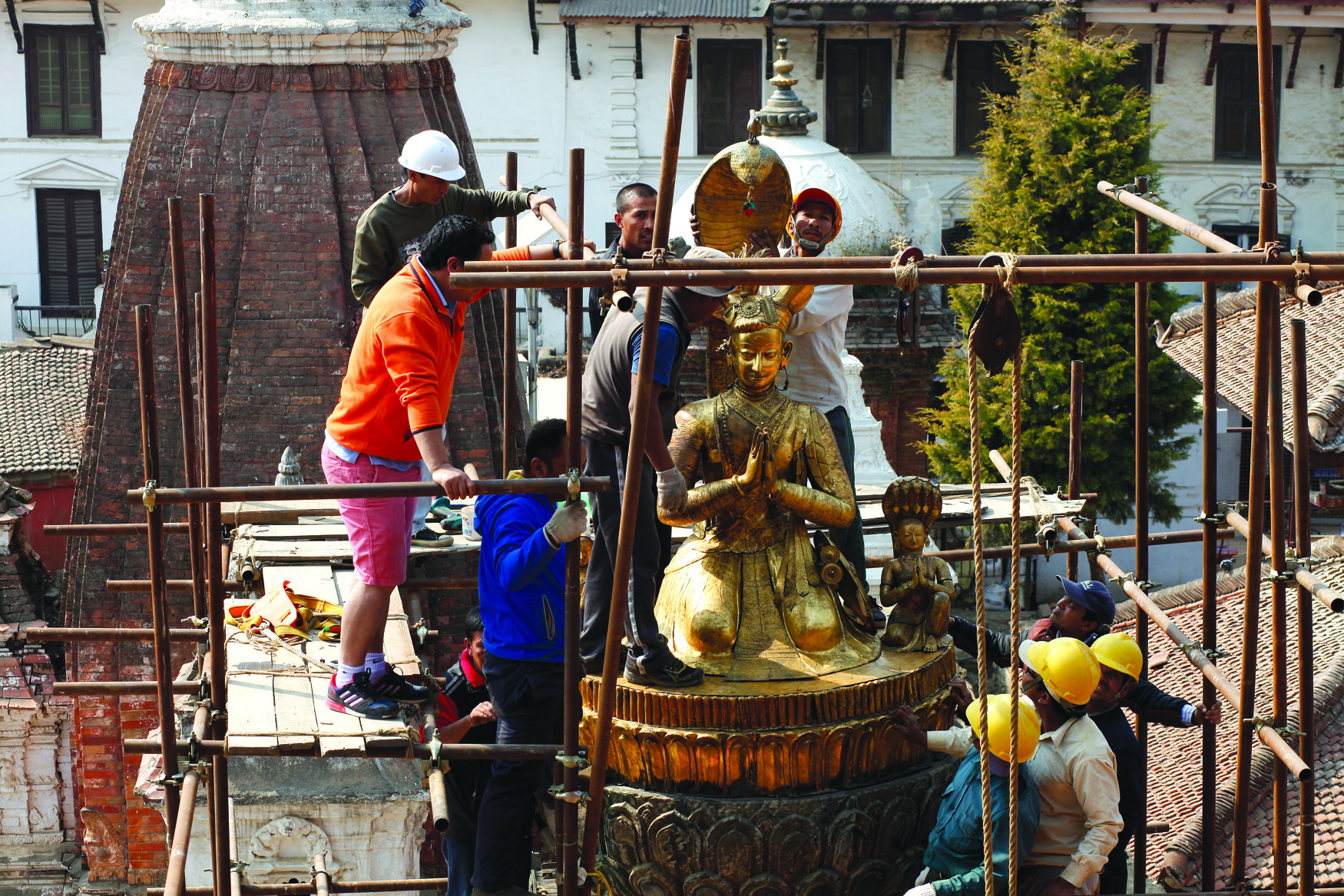Sex and the city of Patan
An erotic shadow play show this week exposes the infidelity of a king 350 years agoYog Narendra Malla became king at age 18, and ruled Patan from 1684-1705 — his reign marked by a cultural and architectural renaissance of the city state.
He put up a statue of himself in the palace square with a little bronze bird sitting on the guardian serpent above his head. It is said he told his subjects that he would look after their welfare till the day the bird flew off.
During the 2015 earthquake, the pedestal collapsed and the statue was damaged. The bird was lost, only to be located in a pile of debris and reinstated when the statue was consecrated two years later.
History remembers Yog Narendra Malla as a wise king, but like most royalty of the day, he had a weakness for women. He is supposed to have consorted with 30 queens and numerous concubines. At least 33 of them self-immolated themselves on the king's funeral pyre when he died, adhering to the prevailing practice of sati.
When Yog Narendra Malla’s favourite queen found out that he was carrying on with yet another woman, she got the local community of the Kwelachhi neighbourhood to stage a shadow sex play to quite literally expose his unfaithfulness.
Actors enacted the explicit exploits of the king and his mistress, a bright butter lamp projecting the moving shadows of their lovemaking on a thin white drape to entertain those gathered in the square below.
The queen made sure that the show was designed to face the home of the king’s paramour to shame them both. She also paid for a group to chant a bhajan with lyrics that ridiculed the king’s extramarital affair.
The Jhyalcha Guthi community trust that the queen set up three-and-half century ago is still active to this day, and performs the annual shadow play in the same building in Kwelachhi the day before Indra Jatra every year. This year’s show is on Friday evening, 5 September.
The opening lines of the chants that accompany the play are the same words approved by the queen all those years ago: “Raja Yog Narendra ya aparadh…” (King Yog Narendra’s crime…)
The community leader of the Kwelachhi neighbourhood, 62-year-old Baburaja Awale, explains the importance of the event: “This Jhyalcha is our intangible heritage and oral history. We do not have a written format, it has been passed down from generation to generation. Every word of the bhajan is the story of King Yog Narendra Malla.”

Jhyalcha Pyankha, as the ceremony is called, starts with a puja for the Bhimsen — the god of wealth and prosperity, a popular deity in Patan who has a temple dedicated just to him in the palace square.
This is immediately followed by a bhajan of Bhairab performed with traditional Newa musical instruments. Community members serve snacks consisting of samay baji beaten rice, water buffalo chunks, soybean, green veggies, lentils, ginger, garlic and aila liquor.
“In the first act of the shadow play, the man initiates the lovemaking, and in the third it is the woman,” says Laxmi Lal Awale, also a member of the trust that organises the show. The shadow action is all uncensored, but interspersed with scenes of everyday life: the woman is spinning a thread, the king is going about his royal chores, and the two sit down to share sanacha fermented pickle that is popular this time of year.
“Back then, there was no tv, films or YouTube, and yet we managed to stage the shadow play using our own resourcefulness,” says Baburaja Awale. “It is important to continue the tradition.”
The challenge now is to ensure that the younger generation takes over, learning the lyrics of the ancient bhajan. The dafa khala group that performs all over Patan during festivals and religious events is now training teenagers to play the musical instruments and act in the shadow play.
The Jhyalcha was staged even after the 2015 earthquake when the falcha where the bhajan is performed collapsed and they made-do in a tin shed. The structure was later rebuilt with a grant from the group, Photo Circle.
Lalitpur Metropolitan City sets aside a budget of Rs50,000 to organise the Jhyalcha Pyankha every year, but this is not enough and is supplemented by individual donations. The performers including musicians and actors are all volunteers, and take part in it because it is their community duty.
The erotic shadow play was way ahead of its time, not just in its graphic content but the use of contemporary local technology as well as improvisation and pure imagination.
Says Laxmi Lal: “Whatever its origin in the legend of King Yog Narendra Malla and his queen, Jhyalcha also served as a medium of sex education. In the past, women were discouraged from watching the shadow play, but today everyone is welcome, we all watch it together.”
Jhyalcha Pyankha
Kwelachhi, Chyasal, Patan
7PM onwards
Friday, 5 September
writer
Sonia Awale is the Editor of Nepali Times where she also serves as the health, science and environment correspondent. She has extensively covered the climate crisis, disaster preparedness, development and public health -- looking at their political and economic interlinkages. Sonia is a graduate of public health, and has a master’s degree in journalism from the University of Hong Kong.




